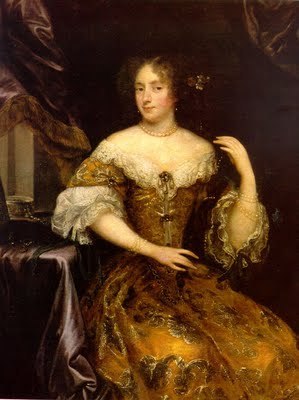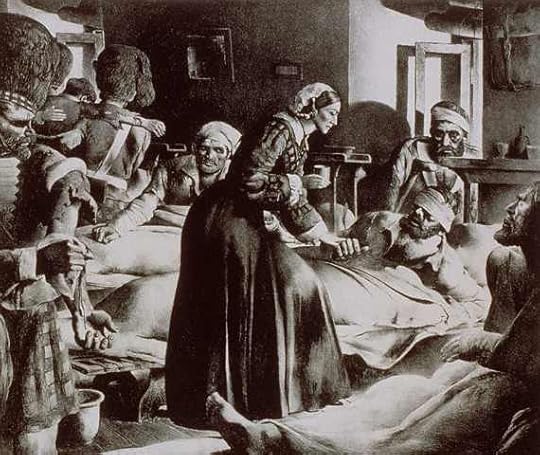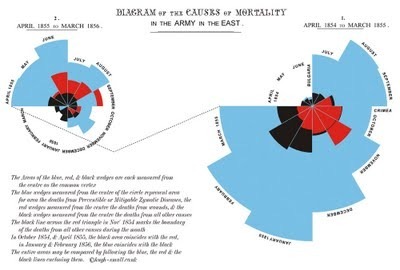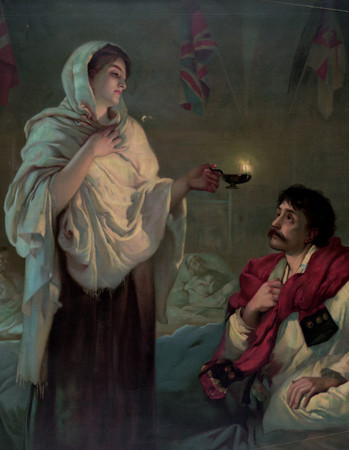Mirella Sichirollo Patzer's Blog, page 52
September 2, 2011
Hoyden of the Week - Snake Charmer
Published on September 02, 2011 17:10
August 26, 2011
Hoyden of the Week - I'll show you mine if you show me yours!
Published on August 26, 2011 17:08
August 20, 2011
Inspirational Women
Published on August 20, 2011 19:34
August 19, 2011
Madame de Sévigné Quote

Madame de Sévigné's remarks to a lady who amused her friends by always going into mourning for some prince, or duke, or member of some royal family, and who at last appeared in bright colors:
"Madame, I congratulate myself on the health of Europe."









Published on August 19, 2011 14:05
August 12, 2011
Hoyden of the Week - A woman to wilt a rose
Published on August 12, 2011 18:05
August 5, 2011
Women Who Rocked the World
Published on August 05, 2011 19:31
August 4, 2011
Florence Nightingale
 Florence Nightingale (1820 - 1910), who died 100 years ago, is well-known as a heroic nurse during the Crimean War. What is less well-known is her remarkable ability as a statistician and her use of these mathematical skills to influence people in authority and bring about real social change.
Florence Nightingale (1820 - 1910), who died 100 years ago, is well-known as a heroic nurse during the Crimean War. What is less well-known is her remarkable ability as a statistician and her use of these mathematical skills to influence people in authority and bring about real social change.When Nightingale arrived in the military base in Scutari (now near Istanbul, Turkey) in 1854, the wounded soldiers were being badly cared for by over-worked medical staff, hygiene was being completely neglected and medicines were in short supply. In short, the camp was overcrowded, unventilated and squalid, with sewers leaking through the walls of the hospital and running across the floor.
16000 British soldiers died from disease in the war (another 2000 from wounds and 2000 in battle) and Nightingale was spurred into action by the squalor she had witnessed and the unnecessary loss of life.
But there was resistance to change from all in authority. Many, even in the scientific community, did not believe in sanitation as a way to improve the care of wounded soldiers. Moreover, many in the establishment didn't care about the well-being of soldiers anyway, considering them almost as low as animals.

Nightingale's use of statistical diagrams was, over time, to change all of this. She recorded the deaths in the camp meticulously and subsequently prepared diagrams based on her data. She is credited with developing a form of the pie chart (shown above) now known as the polar area diagram, or sometimes the "Nightingale Rose Diagram".

The right-hand side of the diagram shows a period of terrible loss of life at Scutari. The area of the blue sectors represents the number of deaths from preventable disease. The left-hand side shows the effects some of the changes had brought about very quickly.
This use of eye-catching graphs was highly innovative. Previously, statistics had been a study of numbers and the data were almost exclusively published in long tables. Indeed, Nightingale gained help from the statistician William Farr, but he originally disapproved of her diagrams.

After the war, Florence Nightingale began campaigning tirelessly. She leaked her report to 100 influential people to try to get information into the public domain. She gained an audience with Queen Victoria and members of the British government. Public support was behind her and the pressure for change was building.
She knew she had a limited time with those in authority and her report needed to show that poor hygiene was unmistakably the cause of death of thousands of men. Her diagram must be so eye-catching as to seize attention immediately. It seemed to work. Eventually the government approved publication of her report.
Slowly, the army adopted sanitary science, statistical medicine, and decent levels of nutrition for soldiers on the battlefield. Army medical practice changed beyond recognition.

What makes Florence Nightingale's achievements all the more remarkable is that, from 1857 onwards, she was largely bed-ridden, due to illness and depression. She influenced many other social reformers, who caught on to the idea of using graphs to convey their message and influence those in authority.
And another legacy of this extraordinary woman's work must be that campaigners in all fields know that to appeal to minds, they must first appeal to the eye.
luke@mathsbank.co.uk
http://mathsbank.co.uk/
Article Source: http://EzineArticles.com/?expert=Luke_Robinson
I LOVE COMMENTS










Published on August 04, 2011 18:14
August 3, 2011
Book Giveaway for Book Clubs by Simon and Schuster Canada!
Attention Book Clubs! Simon and Schuster Canada is excited to announce a contest specifically for book clubs in the fall. Click Book Club for more details.
 I LOVE COMMENTS
I LOVE COMMENTS











 I LOVE COMMENTS
I LOVE COMMENTS










Published on August 03, 2011 08:43
August 2, 2011
Hoyden of the Week - Not tonight honey, I have a headache
Published on August 02, 2011 16:46
July 27, 2011
A Reluctant Queen: The Love Story of Esther by Joan Wolf
 A Reluctant Queen: The Love Story of Esther
A Reluctant Queen: The Love Story of Esther
You've read it as a biblical tale of courage. Experience it anew as a heart-stirring love story. An inspired re-imagining of the tale of Esther, a young Jewish woman thrust from a life of obscurity into a life of power, wealth, intrigue . . . and tender love.
Imagine anew the story of Esther, one of our faith's great heroines, destined to play a key role in the history of Christianity.
She was a simple girl faced with an impossible choice. He was a magnificent king with a lonely heart. Their love was the divine surprise that changed the course of history. The beloved story of Esther springs to fresh life in this inspired novel that vibrates with mystery, intrigue, and romance. See the story of Esther in an entirely new way-with all the political intrigue and tension you remember, but told as a passionate and tender love story between a young man and woman. Misunderstood by many, King Xerxes was a powerful but lonely man. Esther's beauty caught the eye of the young king, but it was her spirit that captured his heart.
The story of Esther in the Bible is inspirational. In the year 485 BC, Esther is a young Persian woman with Jewish roots. When the King of Persia repudiates his first wife, Vashti, he begins a search for a new wife. Young women from all corners of the kingdom eagerly attend hoping to be the one the king will choose. Although unwilling at first, Esther's guardians encourage her to vie for his attention so that she might influence him to keep the Jews from destruction. Esther enters the harem, and much to everyone's surprise, it is she who fascinates the King and ultimately wins his heart. However, she must keep her Jewish roots a secret from her new husband, at great risk to herself.
In A Reluctant Queen: The Love Story of Esther, author Joan Wolf gives a fascinating recounting of this intriguing Bible story. She writes in an easy to read, unencumbered style that allows you to fall into the story easily. I enjoyed the story very much. The beautiful cover art drew me to the novel, but it was the story and easy prose that kept me turning pages. The love story between Esther and the King was brilliantly depicted, as was all the intrigue and power struggles. Esther is an endearing character who goes against all Jewish practices to live an opulent life, very different from the simple life she is used to. This is great Christian fiction – tale of destiny and courage, and sweet love.
I LOVE COMMENTS










Published on July 27, 2011 19:23































